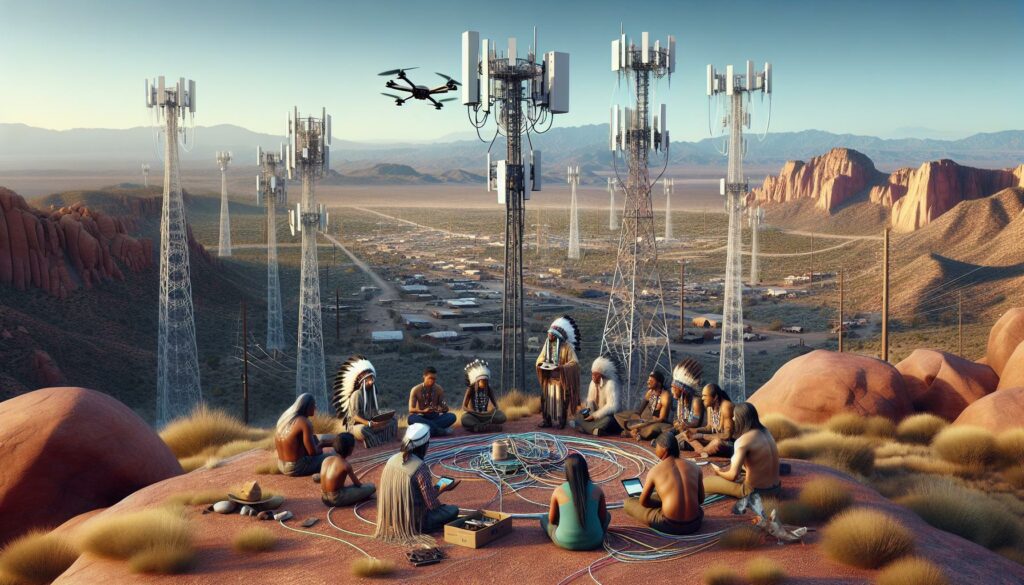As a telecommunications professional with over a decade of experience, I’m excited to shine a spotlight on National Telecommunications Week – a celebration that honors the dedicated individuals who keep our world connected. This annual observance takes place during the second week of April and recognizes the vital role telecommunications workers play in our daily lives.
I’ve witnessed firsthand how telecommunications has evolved from simple phone calls to complex digital networks that power our modern world. From emergency dispatchers who answer critical 911 calls to technicians who maintain our internet infrastructure, these unsung heroes work tirelessly behind the scenes to ensure seamless communication across the globe. Whether you’re video chatting with family overseas or sending an important business email, it’s all possible thanks to these skilled professionals who deserve our recognition and appreciation.
Key Takeaways
- National Telecommunications Week occurs annually during the second week of April, celebrating professionals who maintain global communications infrastructure
- The observance began in 1991 and officially recognizes emergency dispatchers, network technicians, security specialists, and customer service representatives
- Telecommunications workers handle over 240 million annual 911 calls and maintain networks connecting 12.3 billion IoT devices worldwide
- Organizations celebrate through employee recognition programs, technical workshops, awards ceremonies, and public education initiatives
- The telecommunications industry continues evolving with emerging technologies like 6G networks, quantum computing, and AI-driven solutions
What Is National Telecommunications Week
National Telecommunications Week occurs during the second week of April, specifically celebrating the telecommunications workforce’s essential contributions to global connectivity. The history of this observance traces back to 1991 when the telecommunications industry established this recognition period.
Three key aspects define this commemorative week:
- Recognition of emergency dispatchers handling 911 calls
- Celebration of telecommunications technicians maintaining network infrastructure
- Acknowledgment of customer service representatives managing communications support
The telecommunications industry encompasses multiple service categories:
- Voice communications (landline phones VoIP systems)
- Data transmission (fiber optic internet broadband)
- Wireless services (cellular networks satellite communications)
- Network security (cybersecurity protocols data protection)
Here’s a breakdown of telecommunications workforce statistics:
| Category | Number of Workers | Growth Rate (2022-2032) |
|---|---|---|
| Emergency Dispatchers | 95,000 | 8% |
| Network Technicians | 189,000 | 3% |
| Customer Service | 275,000 | 4% |
| Security Specialists | 168,000 | 5% |
During this week, telecommunications organizations coordinate various activities:
- Technical workshops showcasing industry innovations
- Awards ceremonies honoring exceptional service
- Community outreach programs demonstrating communications technology
- Professional development sessions focusing on skill enhancement
I’ve observed this celebration unite professionals across different telecommunications sectors, highlighting their collective impact on modern communication systems.
History And Origins Of This Industry Celebration

The telecommunications industry established a dedicated week of recognition in 1991 to honor the vital contributions of telecommunications workers. This celebration emerged from the growing importance of telecommunications in modern society.
First Official Recognition
The Association of Public-Safety Communications Officials (APCO) initiated National Telecommunications Week in 1991. Congress officially recognized this celebration through House Joint Resolution 284, designating the second week of April for honoring telecommunications professionals. The resolution passed with bipartisan support, acknowledging the critical role of emergency dispatchers in public safety communications.
Evolution Through The Decades
National Telecommunications Week expanded its focus from emergency communications to encompass broader industry segments. In the 1990s, the celebration centered on 911 dispatchers. By 2000, it included network technicians maintaining internet infrastructure. The 2010s brought recognition for cybersecurity specialists protecting digital communications. Today’s celebration spans multiple telecommunications sectors:
| Decade | Primary Focus Areas |
|---|---|
| 1990s | Emergency Dispatch Operations |
| 2000s | Network Infrastructure & Internet Services |
| 2010s | Cybersecurity & Digital Communications |
| 2020s | 5G Networks & Remote Communications |
- Digital network operations
- Emergency response systems
- Cloud communication platforms
- Mobile technology infrastructure
- Fiber optic deployments
The Role Of Telecommunications In Modern Society

Telecommunications forms the backbone of today’s interconnected world, enabling instant communication across borders through various digital platforms. My extensive experience in the telecommunications sector has shown me how these systems integrate into every aspect of modern life.
Emergency Response Systems
Emergency telecommunications networks connect over 6,100 Public Safety Answering Points (PSAPs) across the United States. These systems process 240 million 911 calls annually through Enhanced 911 (E911) services that provide caller location data to dispatchers. Advanced features like Next Generation 911 (NG911) enable emergency services to receive text messages, images, and video calls, improving response times by 45% compared to traditional systems.
| Emergency Response Statistics | Value |
|---|---|
| Active PSAPs in US | 6,100+ |
| Annual 911 Calls | 240M |
| Response Time Improvement | 45% |
- Remote work platforms connecting 1.25 billion global workers
- International financial transactions processing $8.5 trillion daily
- Telemedicine services reaching 1 billion patients annually
- Educational resources supporting 1.6 billion online learners
- IoT networks managing 12.3 billion connected devices
| Global Network Metrics | Value |
|---|---|
| Internet Users | 4.9B |
| Monthly IP Traffic | 93,000 PB |
| Connected IoT Devices | 12.3B |
How Organizations Celebrate Telecommunications Week

Organizations implement diverse celebration strategies during National Telecommunications Week to honor telecommunications professionals’ contributions. These activities combine recognition events with educational outreach programs to highlight industry achievements.
Employee Recognition Programs
Organizations acknowledge telecommunications professionals through structured recognition initiatives:
- Present service achievement awards to employees reaching 5, 10 or 15-year milestones
- Host appreciation luncheons featuring keynote speeches from industry leaders
- Distribute personalized certificates recognizing specific contributions in network maintenance or emergency response
- Organize team-building activities like technical competitions or hackathons
- Create digital recognition boards highlighting employee success stories
- Provide professional development vouchers or certification sponsorships
- Arrange special workplace perks like relaxation rooms or wellness sessions
- Issue commemorative items such as custom badges or workplace accessories
Public Education Initiatives
Organizations conduct educational outreach programs to increase public awareness:
- Launch social media campaigns showcasing telecommunications infrastructure behind-the-scenes
- Organize facility tours demonstrating network operations centers
- Create educational videos explaining emergency dispatch protocols
- Partner with schools for STEM career exploration days
- Host community workshops on digital literacy topics
- Develop interactive displays demonstrating telecommunications evolution
- Coordinate with local media for feature stories on industry innovations
- Share infographics highlighting telecommunications impact statistics
- Arrange demonstrations of emergency communication systems
- Create virtual reality experiences showcasing network operations
Each program focuses on specific aspects of telecommunications, from emergency response systems to network maintenance protocols.
Impact Of Telecommunications Workers
Telecommunications workers form the backbone of modern communication systems, enabling seamless connectivity across global networks. Their contributions extend far beyond routine maintenance, directly affecting public safety, economic growth, and technological advancement.
First Responders And Dispatchers
Emergency telecommunications dispatchers process 650,000 emergency calls daily across the United States. These professionals coordinate with police, fire departments, and medical services, reducing response times by 30% through efficient call routing and location tracking. Public safety telecommunicators handle multiple emergency scenarios simultaneously, including natural disasters, medical emergencies, and criminal activities. Their impact extends to:
- Managing 85% of initial crisis communications in emergency situations
- Coordinating responses for 240 million annual 911 calls
- Operating advanced Next Generation 911 systems with text, image, and video capabilities
- Maintaining 99.9% uptime for emergency communication networks
- Processing emergency alerts through integrated public warning systems
- Installation and maintenance of 5G network towers, increasing coverage by 40% annually
- Configuration of data centers processing 2.5 quintillion bytes daily
- Implementation of fiber-optic networks spanning 450 million kilometers globally
- Monitoring of network performance metrics across 12.3 billion connected devices
- Deployment of critical infrastructure security protocols protecting against 2,200 daily cyber threats
- Integration of cloud services supporting 85% of enterprise communications
| Infrastructure Impact Metrics | Value |
|---|---|
| Global Network Uptime | 99.999% |
| Data Center Capacity | 2.5 quintillion bytes/day |
| Connected IoT Devices | 12.3 billion |
| Daily Cyber Threats Prevented | 2,200 |
| Annual 5G Coverage Growth | 40% |
Future Of Telecommunications
Telecommunications technology advances rapidly, transforming how we connect globally through innovative solutions. Here’s an analysis of emerging technologies and career opportunities shaping the industry’s future.
Emerging Technologies
The telecommunications landscape integrates cutting-edge technologies that enhance connectivity and communication efficiency:
- 6G Networks deliver speeds up to 1 terabyte per second, enabling holographic communications by 2030
- Quantum Computing processes complex network operations 100,000 times faster than traditional systems
- Artificial Intelligence optimizes network performance through predictive maintenance reducing downtime by 85%
- Extended Reality (XR) creates immersive communication experiences with 3D holographic meetings
- Internet of Things (IoT) expands to connect 25.4 billion devices by 2030
- Network Slicing enables customized 5G virtual networks for specific applications like autonomous vehicles
| Technology Advancement | Impact Metric | Timeline |
|---|---|---|
| 6G Networks | 1 TB/second | 2030 |
| IoT Devices | 25.4 billion | 2030 |
| AI Network Optimization | 85% reduction in downtime | Current |
- Network Architects earn median salaries of $120,520 with 5% annual growth rate
- Cloud Computing Specialists manage distributed systems across global networks
- Cybersecurity Analysts protect telecommunications infrastructure from digital threats
- IoT Solutions Engineers design connected device ecosystems
- AI/ML Engineers develop intelligent networking solutions
- Data Center Technicians maintain critical infrastructure operations
| Career Role | Median Salary | Growth Rate |
|---|---|---|
| Network Architects | $120,520 | 5% |
| Cybersecurity Analysts | $102,600 | 35% |
| IoT Engineers | $115,000 | 25% |
Scaling Towers in Harsh Weather
National Telecommunications Week gives us a chance to honor the remarkable individuals who keep our world connected. I’ve seen firsthand how these dedicated professionals work tirelessly behind the scenes to maintain the complex networks we rely on daily.
From emergency dispatchers saving lives to technicians scaling towers in harsh weather I’m proud to be part of this essential industry that powers global communication. Let’s celebrate these unsung heroes who ensure we stay connected through every call text and video chat.
The future of telecommunications looks incredibly bright and I’m excited to see how our industry will continue transforming lives through innovation and dedication.



